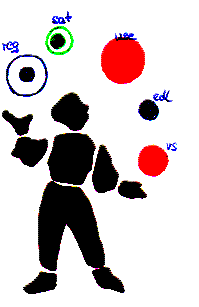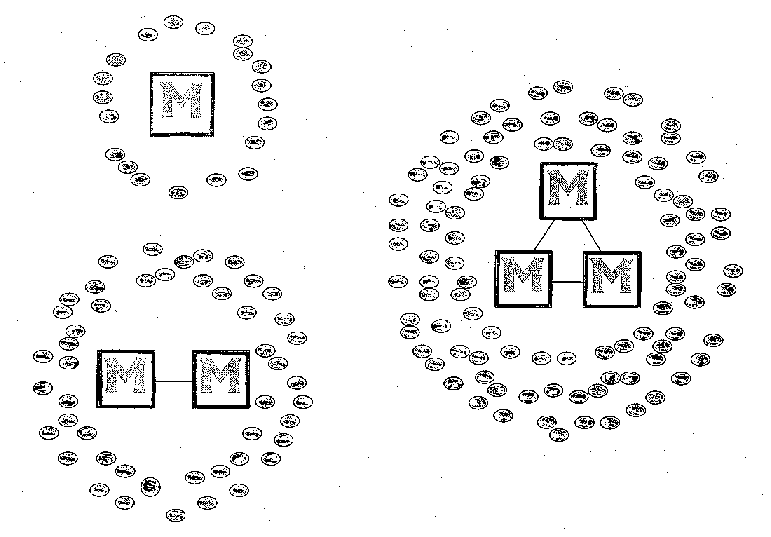

Virtual Tutoring -
A New Approach Challenging Future Developments in Distance Education
- paper presented to the International Conference for Managers of EuroStudyCentres, ESC 97, in Helsinki, November 28, 1997
by Ulrich Bernath
(see also article in German language)
1. A preliminary note
This paper describes an experiment on virtual tutoring. Our experiences necessarily refer to a specific cultural and institutional background, which in this case is characterized by the German distance teaching system of the FernUniversität. Due to federalism in Germany, conventional universities in some of the sixteen states have agreed to offer tutorials for the students of the FernUniversität.
As a result of the experiment with virtual tutoring at Oldenburg university we are able to outline perspectives for the transformation of our tutoring model. As a consequence we can see the impact of tutoring models in general. It is intended that this paper should raise these considerations. However, we strongly recommend that careful reflection be given to individual circumstances, whether in the varied member institutions of the European Association of Distance Teaching Universities or anywhere else.
1. Tutorials for students of the FernUniversität provided by mentors of the Centre for Distance Education at Carl von Ossietzky University of Oldenburg
Degree-seeking students of the distance teaching FernUniversität are centrally served with a correspondence type of tutoring for assignments. Decentralized student support in study centres is provided by mentors in face-to-face meetings. Mentors support students by helping them to understand the content of the courses and, perhaps most importantly, support them within groups of learners to overcome the isolation of distant and dispersed students as well as to encourage the exchange of ideas and learning experiences. Mentors do not share responsibilities for assignments and examinations. They are rather independent partners of the instructors or the instruction of the FernUniversität. The mentor's face-to-face tutorials are voluntary, which puts force on them to attract students.
The FernUniversität is a state-based university of Northrhein-Westphalia, founded in 1975. Students of the FernUniversität in other German states are given support depending on each state's financial policies and their conventional universities' conceptual engagement. In 1978, the state of Lower Saxony set a standard with the establishment of cental units for distance education at three selected universities for state-wide provision. Tutoring and counselling for more than 3.000 students of the FernUniversität in the state of Lower Saxony became a major responsibility at the universities of Hildesheim, Lüneburg and Oldenburg. The development of the concepts is, of course, influenced by their respective conventional university environments. (U. BERNATH 1992and 1994)
Mentors of the University of Oldenburg, responsible for students of the FernUniversität, are offering their face-face-tutorials in a mix of evening classes, day and residential schools. The mix is determined by various factors, such as the specific requirements of the subject areas, students' needs, availability of resources and the overall featuring of the study centre's programme for face-to-face tutorials. The programmes of five North German study centres (including Bremen and Hamburg, Hildesheim, Lüneburg and Oldenburg, which also form a EuroStudyCentre) are harmonized to improve the effectiveness of each study centre's offerings within the greater region.
The above mentioned mix of face-to-face tutorials is an expression of well balanced different forms of tutorial offerings and gives the students an opportunity to "juggle" the options for their individual and voluntary participation. For example, evening classes invite students in the nearest vicinity of a study centre and are regular events. They follow the pace of the course of study. There is empirical evidence that 30 minutes of travel time to meeting with the mentor in a study centre is a limit. (U. BERNATH, G. HOHLFELD 1986) Day schools and, even better, residential schools over a weekend or over a whole week are attractive to students who live far away from the centre. However, the compacted residential schools are singular events.
Students benefit most when they make their own choices for their individual mix. Unfortunately these participants represent only a portion of the student body that we are responsible for. Some of the participants can only make use of either the one or the other form. What strikes us most is that there are other students, who cannot participate in face-to-face tutorials at all, but would like to get tutorial support.
So far, the elaboration of the mix of forms of tutorials was our answer to allow as many students as possible to take part in meetings with their mentors prior to their tests and examinations.
Since the Internet spreads into homes, we became aware that mentoring students through the Internet would help to overcome limitations of our face-to-face tutorials. The crucial distance between the student and the study centre would not play a role any longer and just-in-time tutorials would be made possible for every student by Internet-based communication. With the perspective of winning a lot for the improvement of the distance education format by introducing virtual tutoring we were also facing the loss of the face-to-face component. We were challenged.
In 1996 we started to experiment with virtual tutoring, at the same time that we were experiencing an international virtual seminar for professional development in distance education. (U. BERNATH 1997, U. BERNATH and E. RUBIN 1998)
During the 1996/97 term our mentors, for the first time, offered tutorials using interaction and communication via the Internet
The technological platform was specifically choosen to be at a low cost and easy accessable level following the state of the art standards with the combination of the Web, news groups, e-mail and FTP.
2. New perspectives with virtual tutoring
In 1996/7, we added a tiny little "ball" to the "juggling game" for our distant students interested in tutorial support. Our first experiences were created under every-day working conditions and without the fuzzy-effect of grants.
Reflection on our first practical experiences suggests that we should intensify developments towards virtual tutoring. We already can foresee how this new form will change the weight of each "ball" in the mix of tutorial forms. A reallocation of resources will necessarily happen due to limited resources. Virtual tutoring is, in structure, different than face-to-face forms. It will consequently play a different, but complementary, role to the existing forms.
We gained a lot of new dynamics for playing the future "game". Virtual tutoring and face-to-face tutorials at residential schools seem to match perfectly and seem to be the big "balls" in future.


legend: | reg (evening classes); sat (day school on Saturdays); wse (residential school on weekends); edl (residential school over a week); vs (virtual tutoring) |
Virtual tutoring was experienced as complementary to an already existing mix of various forms of face-to-face tutorials. It is important to see the circumstances in which the experiment took place. This necessarily relates the outcomes to our cultural, institutional and organisational context.
In any case, to go beyond the traditional scope of face-to-face-tutorials by applying virtual tutoring it will require a reasonable investment in infrastructure and personnel as well as leadership and management that steers the change processes successfully.
Tutors and mentors, experienced in correspondence and face-to-face tutoring, should be considered as a backbone in such a strategy. They will play their role when they interact with the application of the new media and understand the different interaction and communication processes of virtual tutorials.
Tutors and mentors clearly deserve professional development to appropriately make use of the potentials of the new media. The complex change processes requires formative evaluation, which will allow ongoing reflections and revisions for future developments.
One of our most important findings is that virtual tutoring will not substitute for all face-to-face tutorials. There are consequences for both directions. Regular evening classes will face hard times to compete with virtual tutoring. That will happen on the one side, while on the other side virtual tutoring will perfectly match with residential schools.
Anyway, practical experiences and pedagogical considerations will work strongly to keep the personal and direct contact between teacher and student alive. There is a rationale for tying together the complimentary functions of virtual and face-to-face tutoring, preferably in one and the same mentor.
Experiments with virtual tutoring are still marginal in our environment. To enter the mainstream and to support distance teaching one must keep in mind a few overall criteria. Virtual tutoring must
Restructuring and redesigning the format for tutorials forces collaborative efforts. With the experience of mentors in their respective academic fields one must build on these human resources. Existing experiences in inter-institutional cooperation are another excellent prerequisite for the establishment of networks of mentors and study centres to better meet the needs of large numbers of students. The experimental one-mentor-to-many-students relation will then evolve. Mentors will form teams and accomplish the need for serving larger groups of students.

It is necessary to underline that virtual tutoring is a group-oriented approach. It benefits from individualized interaction and"witness-learning". (H. FRITSCH 1997) We found that the activity scheme of participants in virtual seminars and virtual tutorials is quite different to face-to-face events. Many more participants can raise their issues at the same time in a virtual environment. This causes a significant increase of visible activities. On the other hand each input may satisfy other participants and may cause their "inactivity" on screen. There are good reasons to receommend a student-mentor ration of 20:1 for virtual tutoring. As a result, for good communication in virtual seminars limiting "seat" capacities is an imperative. With more mentors networking in a team the "seat" number can proportionally be increased. The benefit of a team approach will primarily not be in terms of numbers. The benefit of the team can be realized in terms of just-in-time services and of the quality of the tutorial.
The majority of mentors are employed on a part-time basis, which limits their availability for interaction on line. In contrast, teams of mentors can compile each of their limited resources into to a reasonable amount of hours and with these they will be able to optimize their total presence on line. Furthermore the written inputs for communication are documents which will be reviewed by the team members. The "archive" as a team product will be of much higher value than any individual data base. "Archives" are spin-offs of the written on-line communication in virtuals tutorials. They constitute another advantage of strategic importance for future developments.
Virtual tutoring is a new approach. One can see at the horizon promising perspectives for the development of distance learning and training. Space and time are going to lose their constraining effects on interaction and communication in distance education. Virtual tutoring has the potential to enable, better than any other practiced form, interaction and communication between the mentor and his or her students.
References
This paper is a short English version of:
U. BERNATH, A. KLEINSCHMIDT 1998, Mentorielle Betreuung im Internet
- Eine Herausforderung für die Weiterentwicklung des Fernstudiums,
manuskript 1998, 8 p.
See:
http://www.uni-oldenburg.de/zef/literat/intbetr.htm
U. BERNATH, G. HOHLFELD 1986, Der Einfluß räumlicher Distanz auf die Lernsituation von Studenten der FernUniversität - GHS - Hagen im Einzugsgebiet des Fernstudienzentrums der Universität Oldenburg. (Studien + Berichte / Universität Oldenburg, Zentrale Einrichtung Fernstudienzentrum; 2), Oldenburg 1986, 19 S. (return to article)
U.
BERNATH 1992, Zur Stellung und zum Stellenwert der Mentorentätigkeit
im Fernstudiensystem der FernUniversität Hagen, in: Lehre
und Betreuung im Fernstudium, Abschlußbericht zum Ringkolloquium
des ZIFF im Wintersemester 91/92, hrsg. v. Nicola-Maria Bückmann
u.a., FernUniversität - Gesamthochschule - in Hagen, Mai
1992, S. 75 - 87
see also:
http://www.uni-oldenburg.de/zef/literat/mentoren.htm
(return to article)
U. BERNATH 1994, The Centre for Distance Education at Carl von Ossietzky University of Oldenburg, in: Open Learning, Vol.9, Number 3, November 1994, S. 52 - 55 (return to article)
U.
BERNATH 1997, Lernen im Internet: "A Virtual Seminar for
University Faculty and Administrators - Professional Development
in Distance Education", in: Medien in der Wissenschaft, Band
6, Waxmann: Münster (to be published in 1998); see also:
http://www.uni-hildesheim.de/zfw/lak/Veranstalt/Texte/VS.htm
(return to article)
H. FRITSCH 1997, Witness-Learning. Pedagogical Implecations of Net-based Teaching and Learning, in: Medien in der Wissenschaft, Band 6, Waxmann: Münster (to be published in 1998) (return to article)
U. BERNATH, E. RUBIN 1998, A Virtual Seminar for International Professional Development in Distance Education, in: Informatik-Forum, Fachzeitschrift für Informatik, Band 12/1 (to be published in 1998) (return to article)